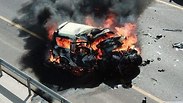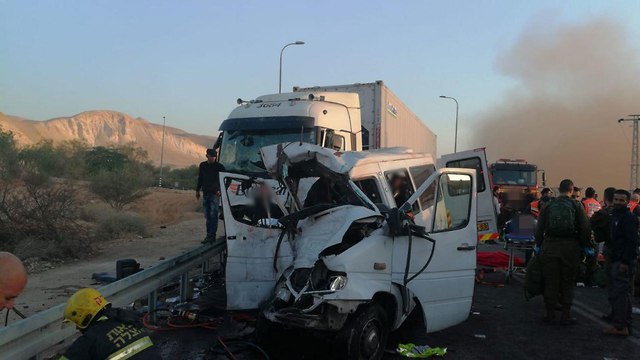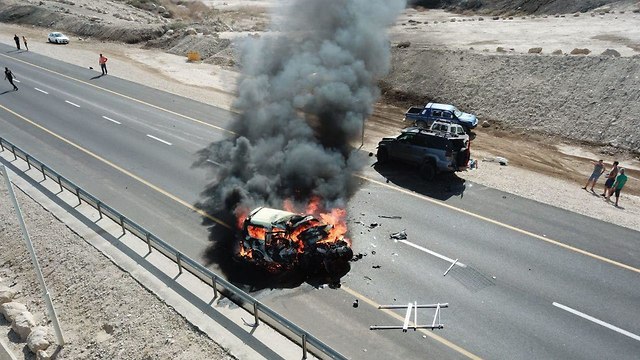

Israel's Highway 90: An unforgiving road
Highway 90 has claimed 17 lives over the past two weeks, and not for the first time. The newest sections along its 480 kilometers are 50 years old, while the oldest are from the Ottoman rule. Meanwhile, renovations and the installation of safety measures are nowhere in sight. A look at one of Israel's most dangerous roads.
The highway is the same highway, only the victims’ names change. On Sunday it was six workers, whose transit hit a truck that deviated from its course. It was the third fatal accident on Highway 90 in two weeks. About a year ago, a truck driver was killed at the exact same road curve.
Highway 90 is an unforgiving road, that doesn't differentiate Jews from Arabs, women from men, parents from children. Accidents hardly ever happen anymore due to technical failures; they happen when a driver makes a mistake or acts in a negligent manner. On a more forgiving road, an accident caused by human error might end in body work repairs rather than have deadly consequences.
This is what happens on roads that have a guard rail between lanes that prevents frontal collisions, roads with less sudden and surprising turns, or roads with side railings that absorb the impact. But Israel’s longest road, from its northern border to its southern one, is no such road.
Highway 90's 480 kilometers include sections from the Ottoman and British Mandate times. Its most recent “Israeli” sections, to the north of the Dead Sea, were paved after the 1967 Six-Day War, with the knowhow and resources of the late 1960’s.
There isn't a more peripheral road than Highway 90—the segment where the Sunday's accident happened, along the Jordan Rift Valley, is the lifeline of the surrounding peripheral communities and of the city of Beit She'an, while the more southern segment in the Arava is the lifeline of the communities there and of the Dead Sea factories, as well as the main road to Eilat.
And yet, only 80 kilometers of this road are a modern, two lane, two-way highway, with quality asphalt and security railings—like you would expect a central highway in a startup nation to be.
As always, this crisis is about money. The state only adds a second lane to roads through which 15,000-20,000 cars pass each day. But only several thousands of cars use daily the section where the recent accident took place. In the more southern parts of the road, there's an average of around 10,000 cars a day.
But these statistics don’t include the number of casualties: Since 2003, 233 people died and 700 were seriously injured on Highway 90. On a one-lane road, the chances of getting killed in an accident are 2.7 times higher than on a two-lane road.
Most of the Jordan Rift Valley section of Highway 90 is on the other side of the Green Line. Israel definitely knows how to invest funds in West Bank infrastructure for security reasons, like the expensive renovations on Highway 60, but Highway 90 is left forgotten. A few months ago, Transportation Minister Yisrael Katz ordered a new statutory plan for the expansion of the Jordan Rift Valley road section, but plans are not enough. There is still no timetable, and the cost will be in the billions.
The National Roads Company of Israel has already expanded the highway in the south, from Eilat to Yotvata, and construction in its northern part continues alongside a plan to expand 130 kilometers more of the highway, all the way to the Arava Junction, with a price tag of NIS 2.1 billion.
Funding is expected to trickle slowly: the infrastructure deputy director in the Ministry of Transport said this week that the plan is to complete about 10 kilometers per year, which means finishing the works after 2030. There will be attempts to work on several sections simultaneously.
According to estimates, the traffic on Highway 90 is expected to grow after the Eilat Airport is moved to Ovda, which is 20 kilometers away from the city. When adding to that the future closure of Sde Dov Airport in Tel Aviv, the journey to Eilat by plane becomes just as long the car ride, which means the road is going to be even more packed. In the upcoming holiday season, Highway 90 is going to be swamped with excited families on their way south on vacation. How many of them are going to make headlines, after the next accident?
Following the horrific accidents of the previous weeks, the Transportation Ministry ordered the National Roads Company to begin planning the construction of guard-rails between lanes along dangerous curves of Highway 90 in the Dead Sea region. However, building such a rail without expanding the road itself creates its own dangers. Expanding the road would be an expensive plan, of about NIS 25 million per kilometer.
Israeli drivers bring in about NIS 40 billion a year in taxes, but when the need arises to invest those taxes back in roads to provide a safe infrastructure—the Treasury has more urgent matters to fund.
“Highway 90 continues to claim lives as a result of poor infrastructure, which is unforgiving to human error,” said Erez Kita, the head of Or Yarok, an NGO that works to encourage safe driving in Israel.
“It’s a 50-years-old road, and its infrastructure should have been upgraded. It’s always easiest to blame the drivers, but not every mistake should end in death, and the infrastructure is meant to protect drivers even if they make a mistake. The Transportation Ministry knows which dangerous roads are prone to accidents and casualties, and so they have to improve infrastructure tomorrow, and not wait for more victims,” Kita added.
The recent spate of accidents on Highway 90 stand in contrast to the improving statistics regarding other roads in the country, and could nix the possibility of 2018 being declared the year with the least car crash casualties in half a century.
The Transportation Ministry's spokesman said on Sunday that, “the ministry expresses its condolences and sorrow to the families of the victims, and wishes the injured a quick recovery.”
“The claim that a guard rail should be installed along the entire Highway 90 is absurd and not practical,” he added, “the road is regularly maintained by the National Roads Company, and the ministry's director-general has now ordered an examination into the need for railing installations or other safety measures in several sections of the road. The attempt to portray the government as responsible for these tragic accidents, while ignoring the drivers' serious and dangerous mistakes, is wrong and untrue.”

















